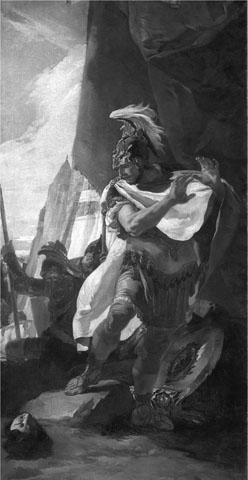

Copyright 2015 Eve MacDonald
All rights reserved. This book may not be reproduced in whole or in part, in any form (beyond that copying permitted by Sections 107 and 108 of the U.S. Copyright Law and except by reviewers for the public press) without written permission from the publishers.
For information about this and other Yale University Press publications, please contact:
U.S. Office:
Europe Office:
Typeset in Adobe Garamond Pro by IDSUK (DataConnection) Ltd
Printed in Great Britain by Gomer Press Ltd, Llandysul, Ceredigion, Wales
Library of Congress Cataloging-in-Publication Data
MacDonald, Eve.
Hannibal : a Hellenistic life/Eve MacDonald.
pages cm
Includes bibliographical references and index.
ISBN 978-0-300-15204-3 (cloth : alkaline paper)
1. Hannibal, 247 B.C.182 B.C. 2. Hannibal, 247 B.C.182 B.C.Influence. 3. Hannibal, 247 B.C.182 B.C.Military leadership. 4. GeneralsTunisiaCarthage (Extinct city)Biography. 5. Punic War, 2nd, 218201 B.C. 6. RomeHistoryRepublic, 265-30 B.C. 7. Carthage (Extinct city)History. I. Title.
DG249.M33 2015
937.04092dc23
[B]
2014035399
A catalogue record for this book is available from the British Library.
10 9 8 7 6 5 4 3 2 1
To my aunt, Elizabeth (Betty) MacDonald (19302011),
for her inspiration and encouragement
C ONTENTS
ILLUSTRATIONS
Plates
Bronze gilt cuirass from Ksour es-Saf, Tunisia, c. third century BCE . Tunis, Muse National du Bardo.
View from Eryx towards Drepanum (Trapani) and the Aegates Islands. Authors photograph.
The Oath of Hannibal by Benjamin West, 1770. Royal Collection Trust Her Majesty Queen Elizabeth II 2014.
The Oath of Hannibal, eighteenth-century cartoon. Courtesy of the Trustees of the British Museum.
Punic di-shekel showing Melqart (possibly Hamilcar) with club on obverse and an elephant and rider on reverse, dated c. 237209 BCE . Courtesy of the Trustees of the British Museum.
Hannibal Crossing the Alps by Heinrich Leutemann, 1866, etching, hand coloured. Held in the public domain at Yale University Art Gallery.
Hannibal with the head of Hasdrubal, Giambattista Tiepolo, 17251730. Kunsthistorisches Museum, Vienna.
Hannibals monument in Turkey, commissioned by Atatrk. Authors photograph.
Bust of Hannibal (?) from Capua. Courtesy of the Mary Evans Picture Library.
Maps
The central Mediterranean: Carthage, Rome and Sicily
The western Mediterranean
Carthage and environs
All maps drawn by Stephen Copp.

1. Bronze gilt cuirass from Ksour es-Saf, Tunisia, c. third century BCE . This beautifully decorated cuirass was found in a tomb in the coastal region of Carthaginian territory, south of Hadrumentum. Hellenistic in style it may have been made in Italy and could have belonged to a soldier of Hannibals generation.

2. The view from Eryx (modern Erice) looking west towards Drepanum (Trapani) and the Aegates Islands. The hill top position of Eryx commands the west and north-west coast of Sicily.

3. The Oath of Hannibal by Benjamin West, 1770. The scene of the oath is here imagined in the eighteenth century with romance and exoticism. The focus of the painting is the sacrificial bull and hesitancy of the young boy while the shadowy figure of a romanized Baal lurks above.

4. The Oath of Hannibal, eighteenth-century cartoon. The Bedfordshire Hannibal illustrates just how familiar the story of Hannibals oath was in the eighteenth century when contemporary politicians could be lampooned in the popular media with scenes from the generals life.

5. Punic di-shekel showing Melqart (possibly Hamilcar) and elephant (c. 237209 BCE ). The figure of Melqart is depicted with the Heraklean attribute of a club on the obverse and an elephant and rider on the reverse. The coin was minted in Iberia and is perhaps the most renowned of all the images associated with the Barcid family and their conquests.

6. Hannibal Crossing the Alps by Heinrich Leutemann, 1866. This hand-coloured etching captures the nineteenth-century fascination with the life of the Carthaginian general and the drama of the Alps crossing.

7. Painting by Giambattista Tiepolo, 17251730. This early eighteenth-century painting illustrates the moment when Hannibal recognizes his brother Hasdrubals head after it was catapulted into his camp following the defeat at the battle of the Metaurus (in 207 BCE ).

8. Hannibals head as portrayed on a monument in Gebze near Istanbul, twentieth century. The monument was commissioned by Atatrk and built after his death. Gebze is thought to be a possible location of ancient Libyssa, where Hannibal died.

9. Hannibal(?) marble bust from Capua. The best-known image of Hannibal may not actually be Hannibal. The portrait was found in or near Capua and is clearly that of a helmeted military figure wearing the cloak (paludamentum) of a Roman commander.
ACKNOWLEDGEMENTS
T HERE ARE SO VERY many people who have been incredibly helpful in the process of writing this book. First on that list are my very patient editors at Yale University Press, Heather McCallum and Rachael Lonsdale. I also valued the comments of the anonymous readers who provided a great deal of clarity, useful observations and encouragement, as well as pointing out many errors, problems and omissions. Any left are mine alone. My good friends and colleagues Sandra Bingham and Stephen Copp have helped in the creation of this story in so many ways, including very practical ones. My students at the University of Reading who took the Carthage module and had many ideas, thoughts and comments that helped to focus my thinking on the topic of Hannibal in the final stages of the book. There are also many other good friends, family (often both) and colleagues who have always been willing to encourage and listen when I am sure there were better things to consider than Hannibal again many thanks. The greatest thanks of all must go to my husband, Keith Tracey, whose patience, editorial skills and even more patience helped to make this a much better work.
Next page




















